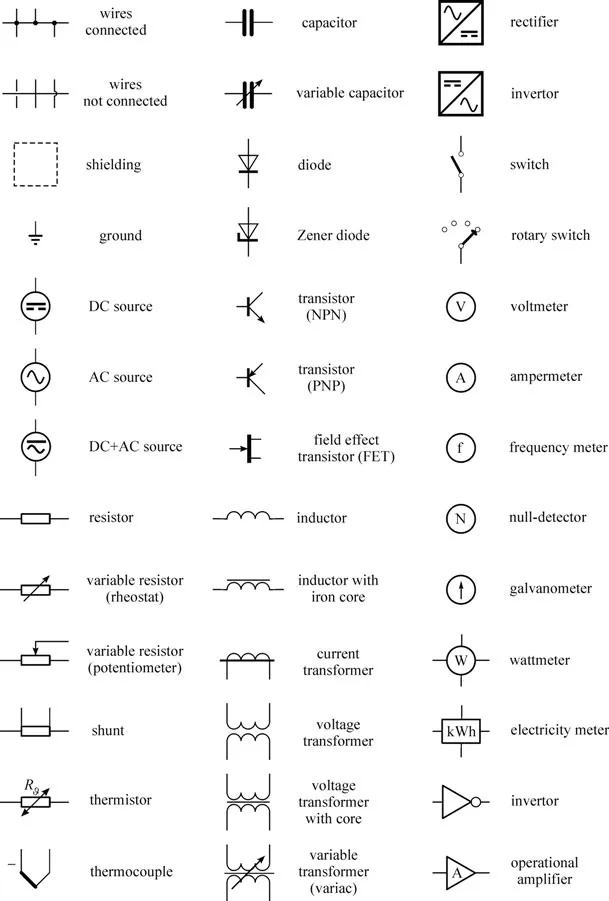Instrumentation and Measurement in
Electrical Engineering
Instrumentation and Measurement in
Electrical Engineering
Roman Malarić
BrownWalker Press
Boca Raton
Instrumentation and Measurement in Electrical Engineering
Copyright © 2011 Roman Malarić
All rights reserved.
No part of this book may be reproduced or transmitted in any form or by any means, electronic or mechanical, including photocopying, recording, or by any information storage and retrieval system, without written permission from the publisher.
BrownWalker Press
Boca Raton, Florida
USA • 2011
ISBN-10: 1-61233-500-4 (paper)
ISBN-13: 978-1-61233-500-1 (paper)
ISBN-10: 1-61233-501-2 (ebook)
ISBN-13: 978-1-61233-501-8 (ebook)
www.brownwalker.com
Some of the electrical symbols used in this book
PREFACE
The inclusion of an electrical measurement course in the undergraduate curriculum of electrical engineering is important in forming the technical and scientific knowledge of future electrical engineers. This book explains the basic measurement techniques, instruments, and methods used in everyday practice. It covers in detail both analogue and digital instruments, measurements errors and uncertainty, instrument transformers, bridges, amplifiers, oscilloscopes, data acquisition, sensors, instrument controls and measurement systems. The reader will learn how to apply the most appropriate measurement method and instrument for a particular application, and how to assemble the measurement system from physical quantity to the digital data in a computer. The book is primarily intended to cover all necessary topics of instrumentation and measurement for students of electrical engineering, but can also serve as a reference for engineers and practitioners to expand or refresh their knowledge in this field.
ACKNOWLEDGMENTS
I would like to thank Ivica Kunšt, dipl. ing for his suggestions and for designing most of the figures in this book. I also wish to thank my colleagues at the Faculty, as well as my colleagues from the TEMUS-158599 project “Creation of the Third Cycle of Studies – Doctoral Studies in Metrology” for their support. Special thanks go to my mother Marija, father Vladimir, and my brother Krešimir for their encouragement and assistance. And finally, thanks to my wife Božica and to my kids for their patience and support.
INTRODUCTION
Measurement followed man from the very beginning of its development. Measuring methods and measuring instruments were developed in parallel with the development of electrical engineering. However, some physical laws were derived based on measurement results, such as the Biot-Savart law, when in 1820, the French scientists Jean-Baptiste Biot and Félix Savart established the relationship between an electric current and the magnetic field it produces. Although science and metrology (the science of measurements) are developing quickly, one should always remember that a measurement principle established more than 150 years ago can still be applicable today. There will be many such principles explained in this book. As the instrumentation becomes more advanced, results will only become more precise.
The basic purpose of metrology is best described by the famous Italian scientist Galileo Galilei: “Measure everything that can be measured and try to make measurable what is not yet measurable.” The term metrology is derived from the Greek words metron–to measure–and logos– science. The process of measurement involves comparison of the measured quantity with the specific unit; it is therefore necessary to know the unit of measurement with the highest possible accuracy. The first modern metrology institute was established in 1887 in Germany. This institute was partly responsible for the sudden rise of strength of German industry in the world. Very soon thereafter, other industrial countries established metrology institutes in order to maintain their places at the top of world industry. With the progress of science foundation around the world, metrology slowly relied more and more on natural phenomena and not on prototypes, as in the past. Today, the only unit of measurement embodied in prototype–kilogram–is stored in Sèvres near Paris, but in recent years, the metrology world appears to desire to define this unit by natural phenomena just like all the others.
Today, metrology is based on natural laws and is unique in how the units can be realized anywhere in the world, if only one has the necessary knowledge and equipment. The foundation of today’s metrology is the International System of Units (SI), adopted in 1960. This system consists of seven base units and a large number of derived units, 23 of which have their own special names and signs. Only electrical current is included in the seven base units from e...




